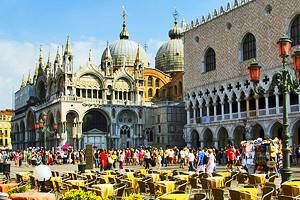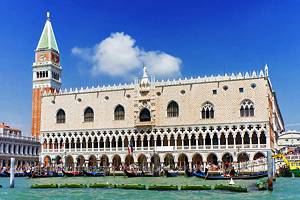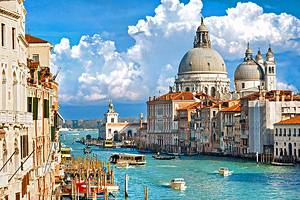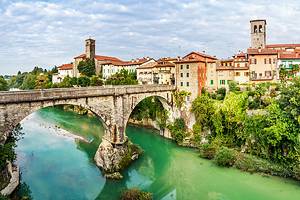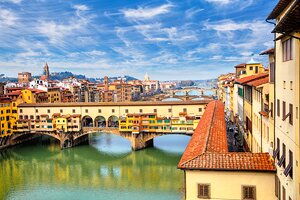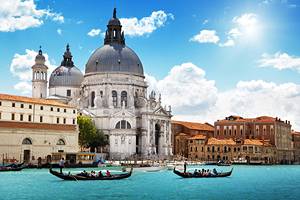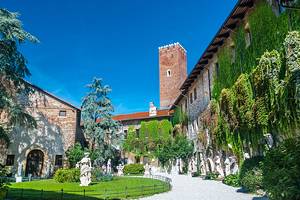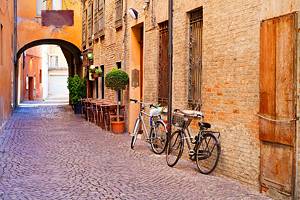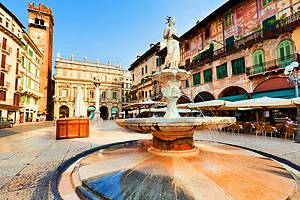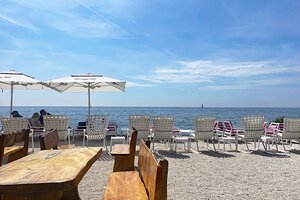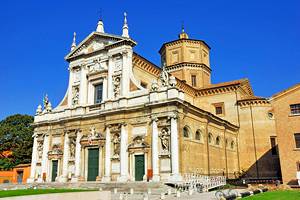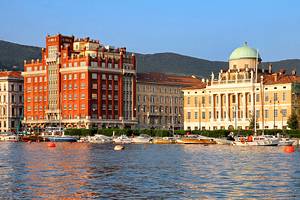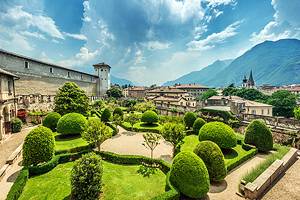St. Mark's Square, Venice: 13 Top Attractions
St. Mark's Square (Piazza San Marco) is Venice on parade, where everyone comes to see and be seen. It is Venice's only square with the title of "piazza" - the rest are called "campo." Life has revolved around this piazza since the days of the Republic, when it was a market, as well as the center of civic and religious life.
Considered one of the finest squares in the world and certainly Venice's prime attraction, it is surrounded on three sides by the stately arcades of public buildings and on the fourth, by Basilica di San Marco's riot of domes and arches and the soaring St. Mark's campanile.
The lines waiting to enter the basilica, which is by far the most popular attraction in Venice, may seem intimidating, but you can skip these by joining a tour. No obstruction mars the vast stone-paved expanse of St. Mark's Square, where the only traffic is Venetians, tourists, and the ever-present pigeons.
Make the most of your visit and find the best things to do with this list of the top attractions and tours in St. Mark's Square.
- Basilica di San Marco (St. Mark's Basilica)
- Palazzo Ducale (Doge's Palace)
- Campanile
- Torre dell'Orologio (Clock Tower)
- Bridge of Sighs
- Museo Correr and Museo del Risorgimento
- Piazzetta and Libreria Sansoviniana
- Linger Over Coffee at a Historic Café
- Procuratie and Ala Napoleonica
- Archeological Museum
- The Church of San Moisè
- San Zaccaria
- Giardinetti Reale
- Map of St. Mark's Square, Venice: Top Attractions
Basilica di San Marco (St. Mark's Basilica)
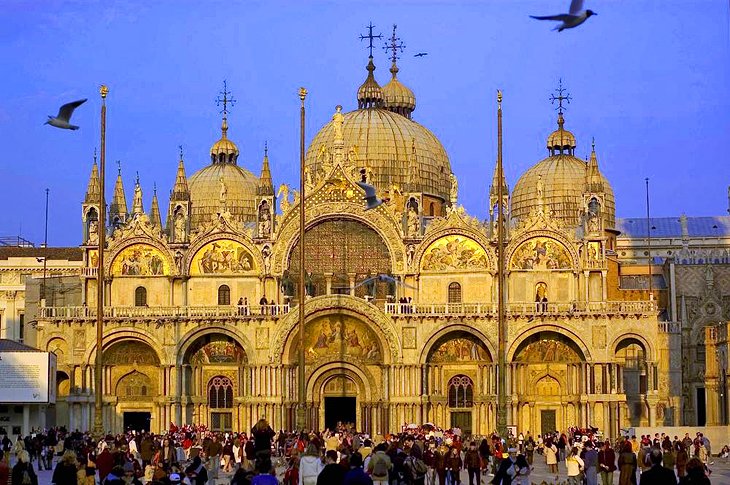
Ever since the remains of St. Mark were brought to Venice in 829, this former chapel of the Doges has been an important religious landmark. And when Venetian crusaders brought back shiploads of Byzantine art treasures after the fall of Constantinople, St. Mark's became wealthy beyond imagination.
Those treasures and the artistry that has been lavished on the basilica over the centuries make it not just a landmark of Venice and Italy, but of all Europe. Highlights to see are the 4,240 square meters covered in ethereal and luminous gold mosaics, the magnificent golden Byzantine retable known as the Pala d'Oro, the inlaid marble floors, and the gold reliquaries and icons in the Treasury.
Because it is the most popular of all the places to visit in Venice, the lines are often intimidating. You can avoid these by joining one of the skip-the-line tours and bypassing the line entirely. You'll also be sure of seeing the most important highlights.
Palazzo Ducale (Doge's Palace)
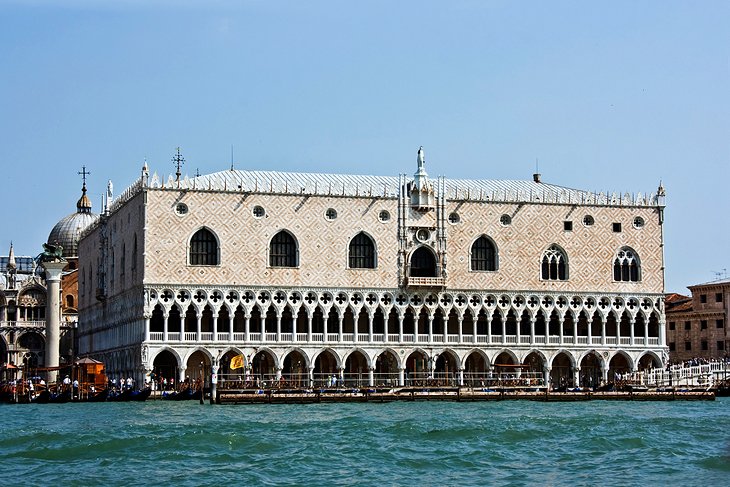
Venice's two most iconic buildings, St. Mark's Basilica and the Doge's palace, stand side by side and are architecturally good foils for each other. The smooth repetition and harmonious, airy design and soft colors of the palace are a refreshing antidote to the busy mix of domes, arches, sculpture, and mosaics of the basilica's façade.
After admiring its exterior and getting an up-close look at the beautiful stone carving in its arcade and the outstanding example of Venetian Gothic in Porta della Carta, take a tour of the interior. Highlights are the Sala del Maggior Consiglio and its monumental oil painting by Tintoretto; Sansovino's golden stairway of Scala d'Oro; and the many paintings by the greatest artists of their time, including Bellini, Carpaccio, Veronese, and Titian.
To be sure you'll see the most important treasures and to avoid the inevitable lines waiting to tour the palace, join one of the skip-the-line tours and explore the huge building with a knowledgeable guide.
Campanile
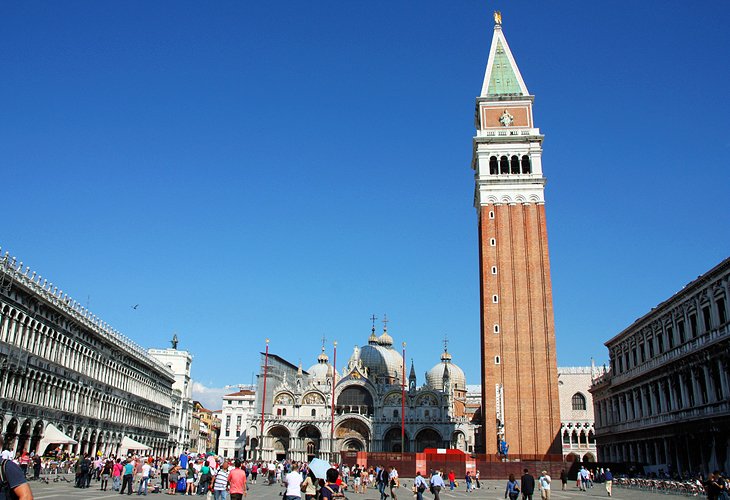
Giving the broad expanse of Piazza San Marco its vertical dimension is the campanile, the tall brick bell tower for the basilica. It towers above the corner of the arcaded Procuratie Nuove, linking the Piazza and the Piazzetta. The campanile is so tall that it was used by approaching ships as a beacon to guide them home.
It was begun in the 10th century and completed in the 12th century, but its pointed roof and gilded pinnacle weren't added until the 15th century. On July 14, 1902, it collapsed into the piazza in a heap of rubble, smashing the Loggetta at its foot but causing no casualties.
By 1912, it had been painstakingly rebuilt to its original 98.6-meter height, as was the Loggetta, a small marble loggia built by Sansovino between 1537 and 1540 for the members of the Great Council to assemble before going into the sessions. After the campanile rubble was cleared, it was possible to rebuild the Loggetta using the original stones and sculptures, including Sansovino's four bronze masterpieces, which stand between the twin columns.
In the Middle Ages, the campanile was also used as a pillory: wrongdoers - including adulterers and renegade priests - were confined in a cage and hoisted halfway up the tower. This breezy punishment could last for several weeks. It has more benign uses today; an elevator will whisk you up to the platform at the top for spectacular views across the city and the lagoon.
Torre dell'Orologio (Clock Tower)
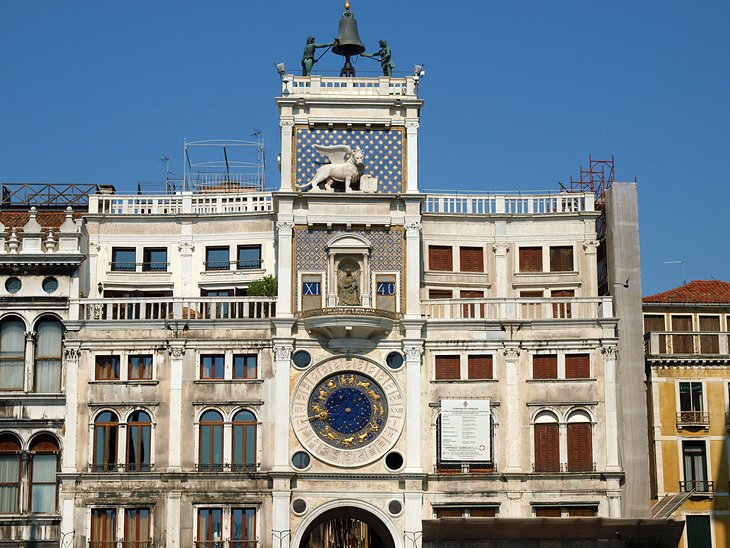
Yet another Venetian icon in Piazza San Marco, the clock tower was designed and built between 1496 and 1499 by Mauro Codussi, probably to finish off the end of the Procuratie Vecchie. It is typical of Venetian Renaissance architecture, although the mosaic of gold stars glittering against a blue background and the Lion of St. Mark were added in 1755 by Giorgio Massari.
The two bronze Mori (Moors) on the terrace who strike the bell to mark the hours were cast by Paolo Ranieri as the tower was under construction. You can climb the tower to get a closer view of these two figures.
The big clock that gives the tower its name was also made by Ranieri and his son, and shows the hours, phases of the moon, and the signs of the zodiac. Above the clock's face is a gilded Madonna, and during Ascension Week and at Epiphany, the Three Kings are led past the Madonna each hour by an angel. The passage to Merceria, a narrow shopping street that's the most direct route from St. Mark's to Rialto Bridge, is through the arch at the base of the clock tower.
The lion of St. Mark beneath the bell is only one of dozens of this icon in Venice. The lion became the city's symbol in AD 828, when the saint's relics were brought here from Alexandria, and you will see them not only in Venice, but in other places that were part of the Venetian Republic. If you take a day trip from Venice, even as far away as Verona, you'll see the familiar winged lion.
Bridge of Sighs
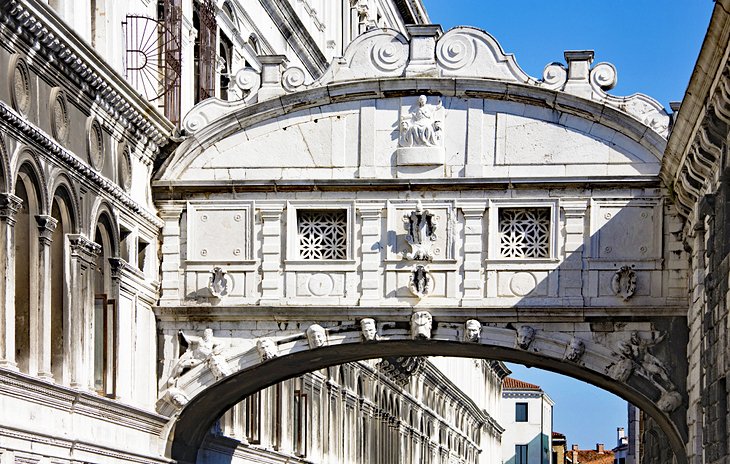
Connecting the Doge's Palace with the Prigioni, a grimmer-than-grim prison for those convicted of crimes or political offenses by judges in the examining rooms of the palace, Ponte di Sospiri crosses the narrow Rio di Palazzo. The enclosed footbridge, with its graceful arch of white limestone and delicate stone tracery covering its two small windows, was designed and built in 1614 by Antonio Contino.
The name, however, came later. Supposedly a traditional name given it based on the sighs of condemned prisoners as they caught their brief final glance of Venice before being thrust into the stifling confinement of the Prigioni, the term was actually a 19th-century invention of the English poet Lord Byron.
Poets aside, there is nothing romantic about the tiny dank cells. Of particular note is the cell in which the famous Giacomo Casanova was held, in a section known as the Leads because of their location just under the lead roof, which made them frigid in winter and sweltering in the summer. It was from this cell that Casanova managed his daring escape in 1775 by climbing out through a hole in the ceiling. (This can only be visited on special tours, not as part of the general admission ticket.)
Museo Correr and Museo del Risorgimento
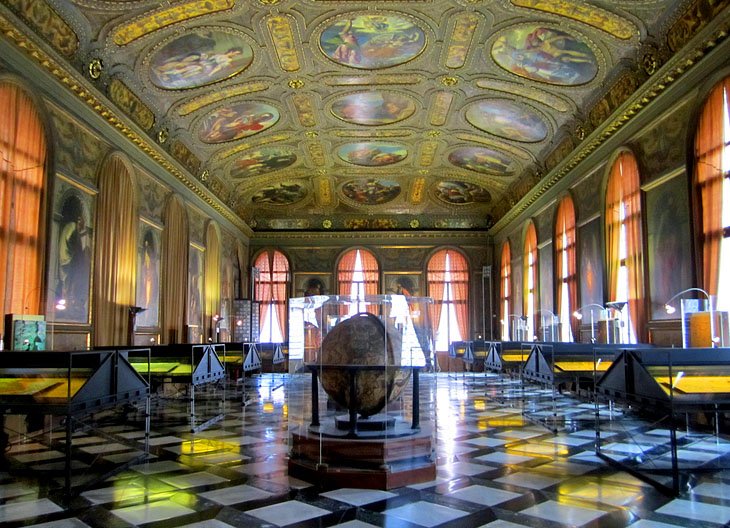
One of the less well-known things to do in Venice is the Correr Museum, which you enter from the end of the piazza through a passage in the Ala Napoleonica. Not only does it have interesting collections illustrating the history of Venice, but it is housed in a series of beautiful early 18th-century interiors. Highlights of the historical collections are exhibits illustrating Venice's architectural development and paintings of scenes from the history of Venice.
State robes of the Doges, Procurators, and Senators add to exhibits on political life, and possibly the most appealing of all are the excellent collections of early lace, silk banners, costumes, and accessories from the 16th through the 18th centuries. An art gallery shows paintings from the 14th to the 17th centuries, including works by Lorenzo Veneziano, the Bellini brothers, and Carpaccio.
The adjoining Museo del Risorgimento illustrates Venice's struggle against Austria, the 1848 Revolution led by Daniele Manin, and union with the kingdom of Sardinia-Piedmont in 1866 and the subsequent unification of Italy.
Piazzetta and Libreria Sansoviniana
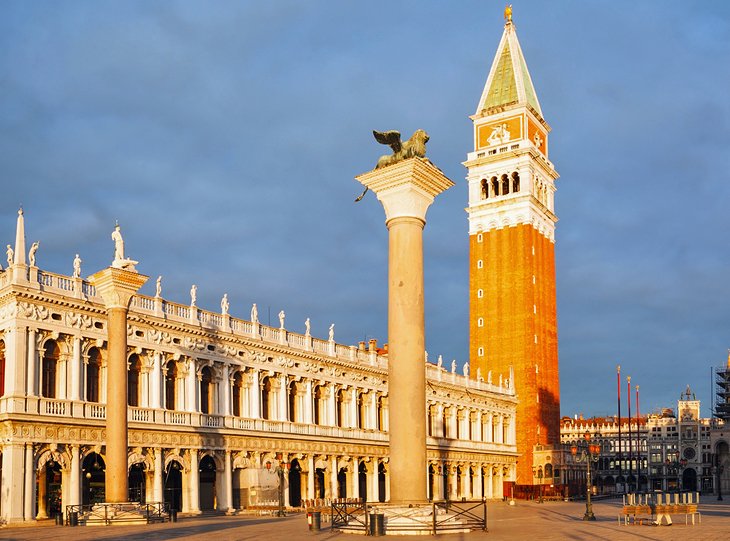
This charming square forms a wide promenade between the Grand Canal and Piazza San Marco, which flows into it in front of the basilica. It's a dramatic approach for visitors - open to the sea and bordered on the right by the Palazzo Ducale. On the left are the arcades of Sansovino's Libreria Vecchia, backed by the campanile on one side and the projecting porch entrance of Basilica di San Marco on the other. In the background are the Torre dell'Orologio (Clock Tower) and the Procuratie.
On the Molo, the open end at the water's edge, stand two columns: Colonna di Marco and Colonna di Teodoro. They have a mixed history. The Doge Michieli actually brought three columns back from Tyre in 1125, but when they were being unloaded, one of them fell into the sea and sank to the bottom of the lagoon.
The other two were set up on the Molo. One of them was crowned with the Lion of St. Mark, which probably began life as an early medieval mythical animal from Persia, later fitted with wings and a book between his paws. Until the 18th century, the lion was gilded.
St. Theodore, who had been the first Patron Saint of Venice until he was superseded by St. Mark, was put on top of the second column. But he, too, had a checkered past, created by a skillful assembling of the head of a Roman Emperor with the body - complete with a dragon - of an early St. George.
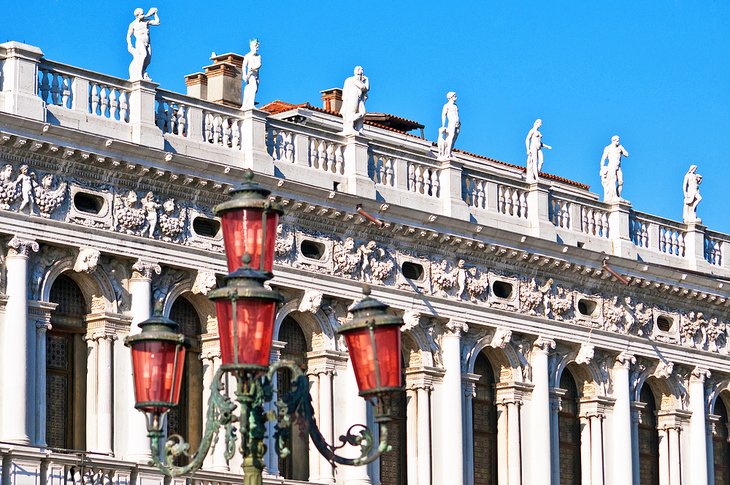
The Libreria Sansoviniana facing the Palazzo Ducale, is the masterpiece of Sansovino, the architect and sculptor, who worked on it between 1536 and 1553. It represents the real turning point of Venetian architecture and the final break with Gothic Venice. From then on, almost all new buildings, especially the palaces, were modeled on his innovation.
The building contains the exhibition rooms of the Biblioteca Nazionale Marciana, decorated with frescoes by Titian, ceiling medallions by Veronese, and portraits by Tintoretto. In the exhibitions, you'll find an astonishing collection of gems, calligraphy, and illuminated books.
Linger Over Coffee at a Historic Café
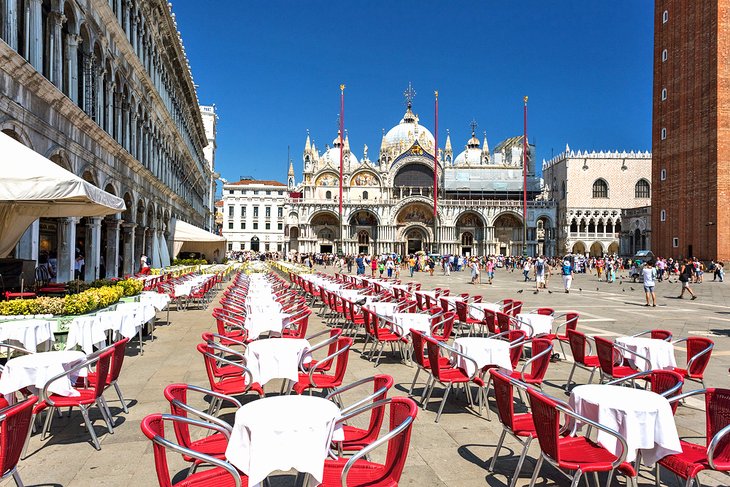
Although it's not for budget-watchers, enjoying coffee and a pastry at one of the elegant and historic cafés overlooking the piazza is a memorable experience. The best time - and the most difficult time to score an outside table - is in the evening, when the lights illuminate the grand façade of St. Mark's Basilica.
As the evening progresses, orchestras play, and you can close your eyes and believe you've slipped back a few centuries, when these cafés were young. The interiors are elegantly ornate, and lingering at an inside table is a guilty pleasure on a blustery day.
The most famous is Caffé Florian, founded in 1720 as "Alla Venezia Trionfante" (In Venice Triumphant). Caffé Lavena was established in 1750. Gran Caffè Quadri has served coffee to writers, poets, musicians, and - more recently - film stars, since Giorgio Quadri arrived in Venice in 1775.
Procuratie and Ala Napoleonica
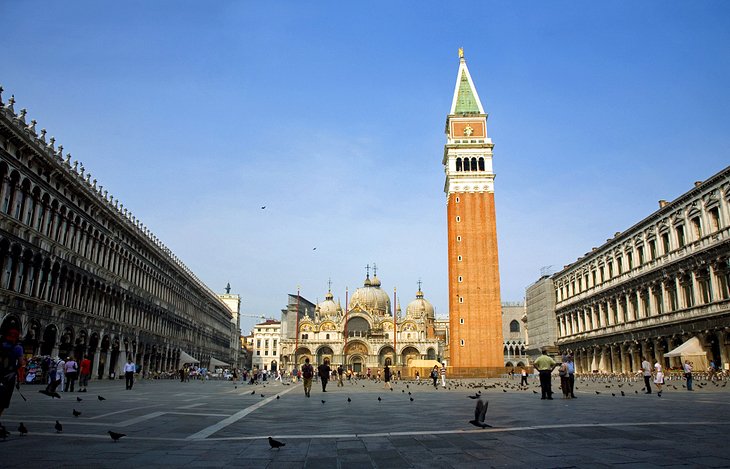
The beauty of Piazza San Marco is largely due to the elegant symmetry and harmony of its three sides, enlivened by the burst of the basilica's over-the-top architecture. The north and south sides of Piazza di San Marco are bordered by the Procuratie, the former offices of the Procurators, the chief officials of the Republic.
As the wealth of St. Mark's increased, it took more than one man to administer it and more office space as well, so the Procuratie Vecchie was built between 1480 and 1517. It is a very fine example of Venetian Early Renaissance architecture, with arcades all along its façade.
By 1582, when even the enlarged Procuratie Vecchie became too small, the Procuratie Nuove was begun on the opposite side of the Piazza, designed to harmonize with the earlier one. Between 1805 and 1814, Napoleon, who had proclaimed himself King of Italy, lived in the Procuratie Nuove whenever he visited Venice.
It was Napoleon who ordered the construction of the third building that finishes off the end of the piazza, now known as the Ala Napoleonica. Today, the buildings house the Museo Civico Correr, Museo del Risorgimento, and the Museo Archeologico.
Archeological Museum
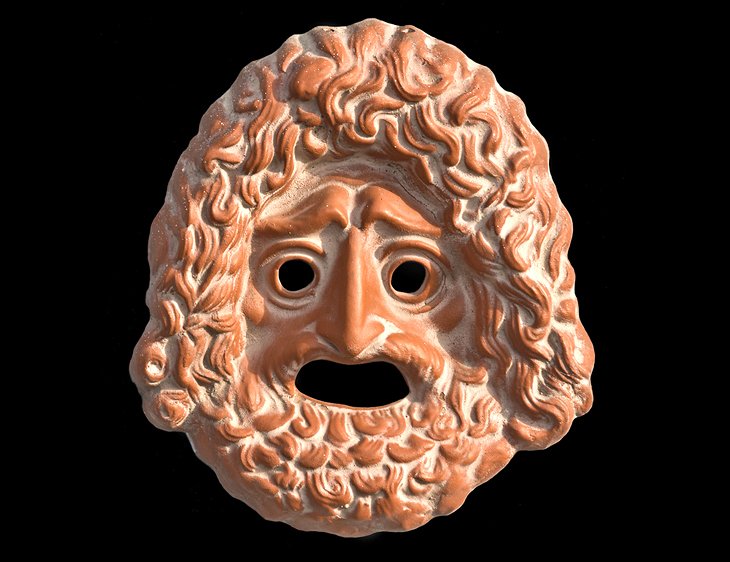
The chief attraction of the Archeological Museum, near the Campanile in the Procuratie Nuove, is the unique chance to compare Classical archaeological finds with later Roman copies and even later Renaissance art to appreciate the tremendous influence of the early works.
Along with the Classical sculptures that influenced the Renaissance artists of Venice, you'll find carved gemstones, cameos, Byzantine ivory-carvings, and Assyrian reliefs from the eighth to seventh centuries BC. The small Egyptian section displays two mummies, along with statuettes and canopic jars.
The Church of San Moisè
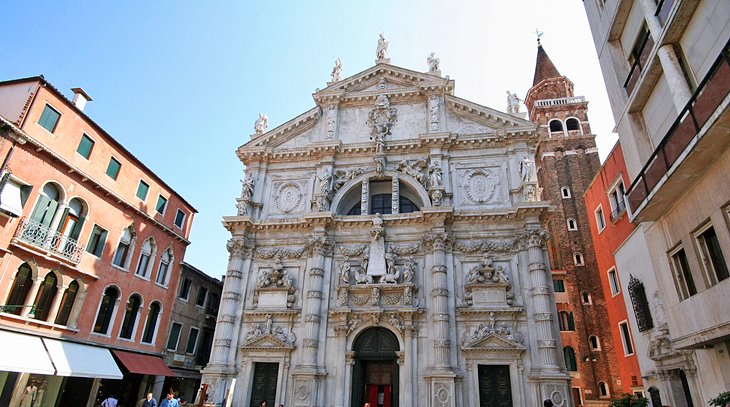
Not strictly speaking in Piazza San Marco, but only a few steps away through the passageway in the southwest corner, you'll come into a little campo and the ornate façade of San Moisè. No one is neutral about this church's Baroque façade, designed by Alessandro Tremignon in 1668. To many, it is simply over-ornate and fussy, but the people of Venice love its elaborate flourishes and sculptures.
Behind it is a square brick bell tower that seems to have no relation to the architecture of the church. Step inside to see the 1732 Pieta on the interior wall of the facade and the Baroque sculpture of Moses on the High Altar.
Address: Campo San Moisè, Venice
San Zaccaria
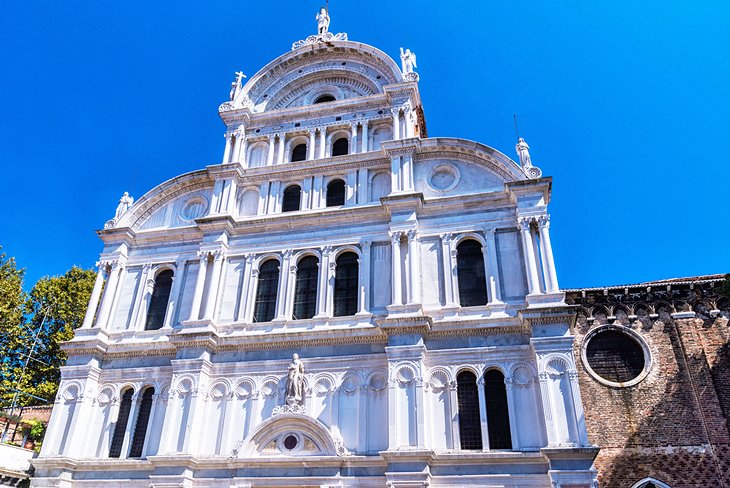
Not actually in Piazza San Marco, but just behind the basilica in Campo San Zaccaria, this was the church of Venice's most elite and prestigious convent, populated and enriched by daughters of Doges and other wealthy pillars of Venetian society who took their vows here.
Their original church was built in 827, and contained the relics of Zacharias, the father of John the Baptist, a gift to Venice by the Byzantine Emperor Leo V. It was replaced by the current church and convent, built from 1444 to 1504. The relics are still here, under the second altar on the right.
To the right is also a door leading to three chapels, the first of which was the nave and one aisle of the former church. The Tintoretto altarpiece depicts The Birth of John the Baptist and to its right is The Flight into Egypt by his son, Domenico Tintoretto. Over the second altar on the left is Giovanni Bellini's Madonna and Four Saints, one of his finest works.
Continue down to the crypt, where the tombs of early doges are mirrored eerily in water that has seeped in from the lagoon, making their columns appear far longer than those on the dry parts of the crypt floor.
Giardinetti Reale
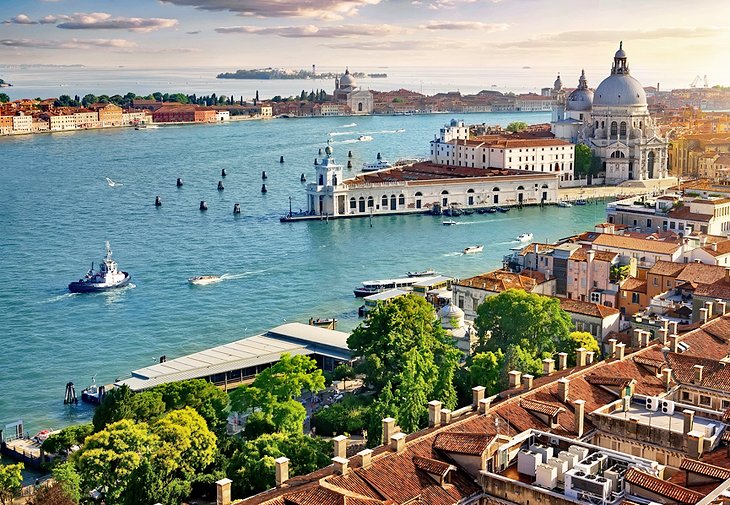
Also not really in Piazza San Marco, but just along the Molo west of the Piazzetta, the Giardinetto comes as a surprise. This little green oasis with its fragrant roses and oleander, pools, and shaded benches, was laid out in the 1800s and takes its name from its location.
This patch of land belonged to the Procuratie Nuove, which served as Napoleon's royal palace. One story is that he ordered it built because the granary that stood here blocked his view of the Grand Canal.




